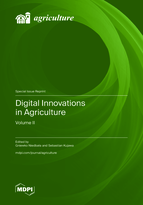Digital Innovations in Agriculture
A special issue of Agriculture (ISSN 2077-0472). This special issue belongs to the section "Digital Agriculture".
Deadline for manuscript submissions: closed (20 February 2023) | Viewed by 243085
Special Issue Editors
Interests: artificial neural networks; artificial intelligence; machine learning; yield modelling; predictions; forecasting; crop production
Special Issues, Collections and Topics in MDPI journals
Interests: artificial neural networks; artificial intelligence; machine learning; yield modelling; predictions; forecasting; crop production
Special Issues, Collections and Topics in MDPI journals
Special Issue Information
Dear Colleagues,
World population is increasing significantly and is expected to reach almost 10 billion in the year 2050. At the same time, observed climate change is accelerating and affecting the agricultural production strongly. These aspects, as well as the latest socio-economic limitations caused by the Covid-19 pandemic, bring new challenges to modern agriculture and the need to have high production efficiency combined with a high quality of obtained products in accordance with the principles of sustainable production. This applies to both crop and livestock production, as well as the other domains related to food production.
To meet these challenges, advanced digital innovation techniques are more and more frequently being used, including those based on machine learning, artificial neural networks, Internet of Things (IoT) and big data. They are widely applied in solving various optimization tasks in the agri-food production processes in the context of the increasing use of precision and digital farming technologies on the path from Agriculture 3.0 to 5.0.
We invite authors to submit all types of manuscripts, including original research, research concepts, communications, and reviews related to digital innovation, widely defined, in the agri-food sector.
Prof. Dr. Gniewko NiedbałaDr. Sebastian Kujawa
Guest Editors
Manuscript Submission Information
Manuscripts should be submitted online at www.mdpi.com by registering and logging in to this website. Once you are registered, click here to go to the submission form. Manuscripts can be submitted until the deadline. All submissions that pass pre-check are peer-reviewed. Accepted papers will be published continuously in the journal (as soon as accepted) and will be listed together on the special issue website. Research articles, review articles as well as short communications are invited. For planned papers, a title and short abstract (about 100 words) can be sent to the Editorial Office for announcement on this website.
Submitted manuscripts should not have been published previously, nor be under consideration for publication elsewhere (except conference proceedings papers). All manuscripts are thoroughly refereed through a single-blind peer-review process. A guide for authors and other relevant information for submission of manuscripts is available on the Instructions for Authors page. Agriculture is an international peer-reviewed open access monthly journal published by MDPI.
Please visit the Instructions for Authors page before submitting a manuscript. The Article Processing Charge (APC) for publication in this open access journal is 2600 CHF (Swiss Francs). Submitted papers should be well formatted and use good English. Authors may use MDPI's English editing service prior to publication or during author revisions.
Keywords
- digital farming
- precision agriculture
- machine learning
- artificial neural networks
- Internet of Things (IoT)
- Big data
- image processing & analysis
- proximal and remote sensing
- data analysis and decision support
- agricultural information systems (FMIS, ERP)
- traceability
- other digital innovations in agriculture







